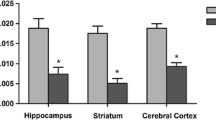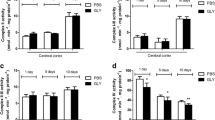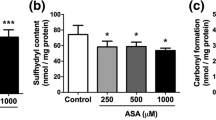Abstract
N-acetylaspartic acid (NAA) is the biochemical hallmark of Canavan Disease, an inherited metabolic disease caused by deficiency of aspartoacylase activity. NAA is an immediate precursor for the enzyme-mediated biosynthesis of N-acetylaspartylglutamic acid (NAAG), whose concentration is also increased in urine and cerebrospinal fluid of patients affected by CD. This neurodegenerative disorder is clinically characterized by severe mental retardation, hypotonia and macrocephaly, and generalized tonic and clonic type seizures. Considering that the mechanisms of brain damage in this disease remain not fully understood, in the present study we investigated whether intracerebroventricular administration of NAA or NAAG elicits oxidative stress in cerebral cortex of 30-day-old rats. NAA significantly reduced total radical-trapping antioxidant potential, catalase and glucose 6-phosphate dehydrogenase activities, whereas protein carbonyl content and superoxide dismutase activity were significantly enhanced. Lipid peroxidation indices and glutathione peroxidase activity were not affected by NAA. In contrast, NAAG did not alter any of the oxidative stress parameters tested. Our results indicate that intracerebroventricular administration of NAA impairs antioxidant defenses and induces oxidative damage to proteins, which could be involved in the neurotoxicity of NAA accumulation in CD patients.




Similar content being viewed by others
References
Aebi H (1984) Catalase in vitro. Methods Enzymol 105:121–126
Adachi M, Torii J, Schneck L, Volk BW (1972) Electron microscopy and enzyme histochemical studies of the cerebellum in spongy degeneration (van Bogaert and Bertrand type). Acta Neuropathologica (Berl) 20:22
Akimitsu T, Kurisu K, Hanaya R, Iida K, Kiura Y, Arita K, Matsubayashi H, Ishihara K, Kitada K, Serikawa T, Sasa M (2000) Epileptic seizures induced by N-aspartate in rats: in vivo and in vitro studies. Brain Res 861:143–150
Arun P, Madhavarao CN, Moffett JR, Namboodiri AMA (2006) Regulation of N-acetylaspartate and N-acetylaspartylglutamate biosynthesis by protein kinase activators. J Neurochem 98:2034–2042
Baslow MH (2002) Evidence supporting a role for N-acetyl-L-aspartate as a molecular water pump in myelinated neurons in the central nervous system—an analytical review. Neurochem Int 40:295–300
Baslow MH (2003) N-acetylaspartate in the vertebrate brain: metabolism and function. Neurochem Res 28(6):941–953
Baslow MH, Guilfoyle DN (2006) Functions of N-acetylaspartate and N-acetylaspartylglutamate in brain: evidence of a role in maintenance of higher brain integrative activities of information processing and cognition. Adv Exp Med Biol 576:95–112
Beaudet A (2001) Aspartoacylase deficiency (Canavan disease). In: Scriver CR, Beaudet AL, Sly WS, Valle D (eds) The metabolic and molecular bases of inherited disease. McGraw-Hill, New York, pp 5799–5805
Bruce AJ, Baudry M (1995) Oxygen free radicals in rat limbic structures after kainate-induced seizures. Free Radic Biol Med 18:993–100
Bubeníková-Valesová V, Balcar V, Tejkalová H, Langmeier M, St’astny F (2006) Neonatal administration of N-acetyl-L-aspartyl-L-glutamate induces early neurodegeneration in hippocampus and alters behaviour in young adult rats. Neurochem Int 48:515–522
Burlina AP, Ferrari V, Divry P, Gradoeska W, Jakobs C, Bennet MJ, Sewell AC, Dionisi-Vici C, Burlina AB (1999) N-acetylaspartylglutamate in Canavan disease: an adverse effector? Eur J Pediatr 158:406–409
Chakraborty G, Mekala P, Yahya D, Wu G, Ledeen R (2001) Intraneuronal N-acetylaspartate supplies acetyl groups for myelin lipid synthesis: evidence for myelin-associated aspartoacylase. J Neurochem 78:736–745
Driver AS, Kodavanti PRS, Mundy WR (2000) Age-related changes in reactive oxygen species production in rat brain homogenates. Neurotoxicol Teratol 22:175–181
Evelson P, Travacio M, Repetto M, Escobar J, Llesuy SF, Lissi E (2001) Evaluation of total reactive antioxidant potential (TRAP) of tissue homogenates and their cytosols. Arch Biochem Biophys 388:261–266
Gehl LM, Saab OH, Bzdega T, Wroblewska B, Neale JH (2004) Biosynthesis of NAAG by an enzyme-mediated process in rat central nervous system neurons and glia. J Neurochem 90:989–997
Gordon N (2000) Canavan disease: a review of recent developments. Eur J of Paediatr Neurol 5:65–69
Halliwell B, Gutteridge JMC (2007) Cellular responses to oxidative stress: adaptation, damage, repair, senescence and death. In: Halliwell B, Gutteridge JMC (eds) Free radicals in biology and medicine. Oxford University Press Inc., Oxford, pp 187–267
Hashida K, Sakakura Y, Makino N (2002) Kinetic studies on the hydrogen peroxide elimination by cultured PC12 cells. Biochim Biophys Acta 1572:85–90
Janson CG, McPhee SWJ, Francis J, Shera D, Assadi M, Freese A, Hurh P, Haselgrove J, Wang DJ, Bilaniuk L, Leone P (2006) Natural history of Canavan disease revealed by proton magnetic resonance spectroscopy (1H-MRS) and diffusion-weighted MRI. Neuropediatrics 37:209–221
Kirmani BF, Jacobowitz DM, Kallarakal AT, Namboodiri MAA (2002) Aspartoacylase is restricted primarily to myelin synthesizing cells in the CNS: therapeutic implications for Canava disease. Mol Brain Res 107:176–182
Kitada K, Akimitsu T, Shigematsu Y, Kondo A, Maihara T, Yokoi N, Kuramoto T, Sasa M, Serikawa T (2000) Accumulation of N-acetylaspartate in the brain of the tremor rat, a mutant exhibiting absence-like seizure and spongiform degeneration in the central nervous system. J Neurochem 74(6):2512–2519
Kletzien RF, Harris PKW, Foellmi LA (1994) Glucose 6-phosphate dehydrogenase: a “housekeeping” enzyme subject to tissue-specific regulation by hormones, nutrients and oxidant stress. FASEB J 8:174–181
Krawczyk H, Gradowska W (2003) Characterization of the 1H and 13C NMR spectra of N-acetylaspartylglutamate and its detection in urine from patients with Canavan disease. J Pharm Biomed Anal 31:455–463
Kumar S, Mattan NS, de Vellis J (2006) Canavan disease: a white matter disorder. Ment Retard Dev Disabil Res Rev 12:157–65
Leong SF, Clark JB (1984) Regional enzyme development in rat brain, Enzymes associated with glucose utilization. Biochem J 218:131–138
Liang LP, Patel M (2004) Mitochondrial oxidative stress and increased seizure susceptibility in Sod2(−/+) mice. Free Radic Biol Med 36:542–554
Liang LP, Ho YS, Patel M (2000) Mitochondrial superoxide production in kainate-induced hippocampal damage. Neuroscience 101:563–570
Lissi E, Caceres T, Videla LA (1986) Visible chemiluminescence from rat brain homogenates undergoing autoxidation I. Effect of additives and products accumulation. Free Radic Biol Med 2:63–69
Lissi E, Pascual C, Del Castillo MD (1992) Luminol luminescence induced by 2, 2′-azo-bis-(2-amidinopropane) thermolysis. Free Radic Res Commun 17:299–311
Lissi E, Salim-Hanna M, Pascual C, Del Castillo MD (1995) Evaluation of total antioxidant potential (TRAP) and total antioxidant reactivity from luminol-enhanced chemiluminescence measurements. Free Radic Biol Med 18:153–158
Llesuy SF, Milei J, Molina H, Boveris A, Milei S (1985) Comparison of lipid peroxidation and myocardial damage induced by adriamycin and 4′-epiadriamycin in mice. Tumori 71:241–249
Lowry OH, Rosebrough NJ, Lewis-Farr A, Randall RJ (1951) Protein measurement with the Folin phenol reagent. J Biol Chem 193:265–275
Madhavarao CN, Arun P, Moffett JR, Szucs S, Surendran S, Matalon R, Garbern J, Hristova D, Johnson A, Jiang W, Namboodiri MAA (2005) Defective N-acetylaspartate catabolism reduces brain acetate levels and myelin lipid synthesis in Canavan’s disease. PNAS 102:5221–5226
Marklund SL (1985) Pyrogallol autoxidation. In: Greenwald RA (ed) Handbook of methods for oxygen radical research. CRC, Boca Raton, pp 243–247
Matalon R, Michals-Matalon K (2000) Spongy degeneration of the brain, Canavan disease: biochemical and molecular findings. Front Biosci 5:d307–311
Mavelli I, Rigo A, Federico R, Ciriolo MR, Rotilio G (1982) Superoxide dismutase, glutathione peroxidase and catalase in developing rat brain. Biochem J 204:535–540
Moffett JR, Ross B, Arun P, Madhavarao CN, Namboodiri AMA (2007) N-acetylaspartate in the CNS: from neurodiagnostics to neurobiology. Prog Neurobiol 81:89–131
Namboodiri AMA, Peethambaran A, Mathew R, Sambhu PA, Hershfield J, Moffett JR, Madhavarao CN (2006) Canavan disease and the role of N-acetylaspartate in myelin synthesis. Mol Cell Endocrinol 252:216–223
Neale JH, Bezdega T, Wroblewska B (2000) N-acetylaspartylglutamate: the most abundant peptide neurotransmitter in the mammalian central nervous system. J Neurochem 75(2):443–452
Ohkawa H, Ohishi N, Yagi K (1979) Assay for lipid peroxides in animal tissues by thiobarbituric acid reaction. Anal Biochem 95:351–358
Patel M (2004) Mitochondrial dysfunction and oxidative stress: cause and consequence of epileptic seizures. Free Radic Biol Med 37(12):1951–1962
Paxinos G, Watson C (2004) The rat brain in stereotaxic coordinates. Elsevier, New York
Pederzolli CD, Mescka CP, Scapin F, Rockenbach FJ, Sgaravatti AM, Sgarbi MB, Wyse ATS, Wannmacher CMD, Wajner M, Dutra-Filho CS (2007) N-acetylaspartic acid promotes oxidative stress in cerebral cortex of rats. Int J Dev Neurosci 25(5):317–324
Pliss L, FitzGibbon T, Balcar VJ, St’astny F (2000) Neurotoxicity of NAAG in vivo is sensitive to NMDA antagonists and mGluR II ligands. Neuroreport 11(16):3651–3654
Pliss L, Jezová D, Mares V, Balcar VJ, St’astny F (2002) N-Acetyl-L-aspartyl-L-glutamate changes functional and structural properties of rat blood-brain barrier. Neurosci Let 317:85–88
Pliss L, Balcar VJ, Bubeníková V, Pokorny J, FitzGibbon T, St’astny F (2003) Morphology and ultra-structure of rat hippocampal formation after i.c.v. administration of N-acetyl-L-aspartyl-L-glutamate. Neuroscience 122:93–101
Pouwels PJ, Frahm J (1997) Differential distribution of NAA and NAAG in human brain as determined by quantitative localized proton MRS. NMR Biomed 10(2):73–78
Reznick AZ, Packer L (1994) Oxidative damage to proteins: spectrophotometric method for carbonyl assay. Meth. Enzymol 233:357–363
Röhrdanz E, Obertrifter B, Ohler S, Tran-Thi Q, Kahl R (2000) Influence of Adriamycin and paraquat on antioxidant enzyme expression in primary rat hepatocytes. Arch Toxicol 74:231–237
Rojo AI, Salinas M, Martín D, Perona R, Cuadrado A (2004) Regulation of Cu/Zn-superoxide dismutase expression via the phosphatidylinositol 3 kinase/Akt pathway and Nuclear Factor-kB. J Neurosci 24(33):7324–7334
Schreiber SJ, Megow D, Raupach A, Victorov IV, Dirnagl U (1995) Age-related changes of oxygen free radical production in the rat brain slice after hypoxia: on-line measurement using enhanced chemiluminescence. Brain Res 703:227–230
Shave E, Pliss L, Lawrance ML, FitzGibbon T, St’astny F, Balcar VJ (2001) Regional distribution and pharmacological characteristics of [3H]N-acetyl-aspartyl-glutamate (NAAG) binding sites in rat brain. Neurochem Int 38:53–62
Skiranth SG, Chandrashekar HS, Nagarajan K, Jayakumar PN (2007) Restricted diffusion in Canavan Disease. Childs Nerv Syst 23:465–468
Stadtman ER, Levine RL (2003) Free-radical mediated oxidation of free amino acids and amino acid residues in proteins. Amino Acids 25:207–218
Thomas AG, Vornov JJ, Olkowski JL, Merion AT, Slusher BS (2000) N-acetylated α-linked acidic dipeptidase converts N-acetylaspartylglutamate from a neuroprotectant to a neurotoxin. JPET 295:16–22
Traeger EC, Rapin I (1998) The clinical course of Canavan disease. Pediatric Neurol 18(3):207–212
Trotti D, Danbolt NC, Volterra A (1998) Glutamate transporters are oxidant-vulnerable: a molecular link between oxidative stress and excitotoxic neurodegeneration? Trends Pharmacol Sci 19:328–334
Wendel A (1981) Glutathione peroxidase. Meth Enzymol 77:325–332
Wilson DO, Johnson P (2000) Exercise modulates antioxidant enzyme gene expression in rat myocardium and liver. J Appl Physiol 88:1791–1796
Yan HD, Ishihara K, Serikawa T, Sasa M (2003) Activation by N-acetyl-L-aspartate of acutely dissociated hippocampal neurons in rats via metabotropic glutamate receptors. Epilepsia 44(9):1153–1159
Yoo HY, Chang MS, Rho HM (1999) The activation of the rat cooper/zinc superoxide dismutase gene by hydrogen peroxide through the hydrogen peroxide responsive element and by paraquat and heat shock through the same heat shock element. J Biol Chem 274(34):23887–23892
Zhao J, Ramadan E, Cappiello M, Wroblewska B, Bzdega T, Neale JH (2001) NAAG inhibits KCl-induced [3H]-GABA release via mGluR3, cAMP, PKA and L-type calcium conductance. Eur J Neurosci 13:340–346
Zielke HR, Zielke CL, Baab PJ, Collins RM (2002) Large neutral acids auto exchange when infused by microdialysis into the rat brain: implication for maple syrup urine disease and phenylketonuria. Neurochem Int 40:347–354
Acknowledgements
This work was supported by the research grants from Programa de Núcleos de Excelência (PRONEX), CAPES, Brazilian National Research Council (CNPq), PROPESQ/UFRGS, PIC/UFCSPA and FINEP — Rede Instituto Brasileiro de Neurociência (IBN-Net) #01.06.0842-00.
Author information
Authors and Affiliations
Corresponding author
Rights and permissions
About this article
Cite this article
Pederzolli, C.D., Rockenbach, F.J., Zanin, F.R. et al. Intracerebroventricular administration of N-acetylaspartic acid impairs antioxidant defenses and promotes protein oxidation in cerebral cortex of rats. Metab Brain Dis 24, 283–298 (2009). https://doi.org/10.1007/s11011-009-9137-6
Received:
Accepted:
Published:
Issue Date:
DOI: https://doi.org/10.1007/s11011-009-9137-6




